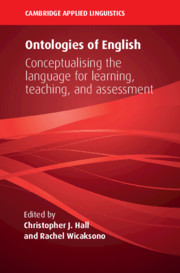Book contents
- Ontologies of English
- The Cambridge Applied Linguistics Series
- Ontologies of English
- Copyright page
- Dedication
- Contents
- Figures
- Tables
- Contributors
- Series Editors’ Preface
- Acknowledgements
- Transcription Conventions
- Part I Introduction
- Part II English in/for L2 Learning and Teaching
- 3 English in the Real World
- 4 From Constructions to Social Action
- 5 Native and Non-native Speakers of English in TESOL
- Part III English in Schools
- Part IV Assessing English
- Part V English in Lingua Franca Contexts
- Part VI English and Social Practice
- Part VII Commentary and Conclusions
- Index
- References
4 - From Constructions to Social Action
The Substance of English and Its Learning from an Interactional Usage-Based Perspective
from Part II - English in/for L2 Learning and Teaching
Published online by Cambridge University Press: 24 December 2019
- Ontologies of English
- The Cambridge Applied Linguistics Series
- Ontologies of English
- Copyright page
- Dedication
- Contents
- Figures
- Tables
- Contributors
- Series Editors’ Preface
- Acknowledgements
- Transcription Conventions
- Part I Introduction
- Part II English in/for L2 Learning and Teaching
- 3 English in the Real World
- 4 From Constructions to Social Action
- 5 Native and Non-native Speakers of English in TESOL
- Part III English in Schools
- Part IV Assessing English
- Part V English in Lingua Franca Contexts
- Part VI English and Social Practice
- Part VII Commentary and Conclusions
- Index
- References
Summary
The fundamental question to be explored in this chapter is what people actually learn when they learn ‘English’, and from this empirical basis distil the categories of the English language and the social-interactional roots of its learning. To this end, I draw on usage-based linguistics (UBL) and ethnomethodological conversation analysis (EMCA). The two-pronged approach combines into an interactional usage-based approach and allows me to capture development over time along two dimensions of L2 learning, namely development of L2 constructional inventories as seen through the lens of UBL and development of interactional competence as evidenced through moment-to-moment microanalyses of interactions (EMCA) over time.
Keywords
- Type
- Chapter
- Information
- Ontologies of EnglishConceptualising the Language for Learning, Teaching, and Assessment, pp. 59 - 79Publisher: Cambridge University PressPrint publication year: 2020
References
- 4
- Cited by

